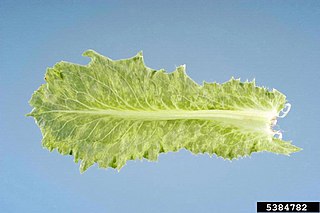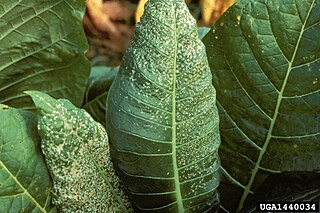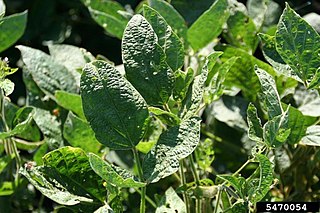Related Research Articles

Tobacco mosaic virus (TMV) is a positive-sense single-stranded RNA virus species in the genus Tobamovirus that infects a wide range of plants, especially tobacco and other members of the family Solanaceae. The infection causes characteristic patterns, such as "mosaic"-like mottling and discoloration on the leaves. TMV was the first virus to be discovered. Although it was known from the late 19th century that a non-bacterial infectious disease was damaging tobacco crops, it was not until 1930 that the infectious agent was determined to be a virus. It is the first pathogen identified as a virus. The virus was crystallised by W.M. Stanley.

Brome mosaic virus (BMV) is a small, positive-stranded, icosahedral RNA plant virus belonging to the genus Bromovirus, family Bromoviridae, in the Alphavirus-like superfamily.

Lettuce mosaic virus (LMV) is a typical potyvirus, which causes one of the major virus diseases of lettuce crops worldwide.

Potyvirus is a genus of positive-strand RNA viruses in the family Potyviridae. Plants serve as natural hosts. The genus is named after member virus potato virus Y. Potyviruses account for about thirty percent of the currently known plant viruses. Like begomoviruses, members of this genus may cause significant losses in agricultural, pastoral, horticultural, and ornamental crops. More than 200 species of aphids spread potyviruses, and most are from the subfamily Aphidinae. The genus contains 190 species.

Papaya ringspot virus (PRSV) is a pathogenic plant virus in the genus Potyvirus and the virus family Potyviridae which primarily infects the papaya tree.
Bean yellow mosaic virus is a plant pathogenic virus in the genus Potyvirus and the virus family Potyviridae. Like other members of the Potyvirus genus, it is a monopartite strand of positive-sense, single-stranded RNA surrounded by a capsid made for a single viral encoded protein. The virus is a filamentous particle that measures about 750 nm in length. This virus is transmitted by species of aphids and by mechanical inoculation.

Bidens mottle virus (BiMoV) is a pathogenic plant virus in the plant virus family Potyviridae. BiMoV is a flexuous filamentous particle, 720 nm long, and belongs to the Potyviridae genus Potyvirus. Like other viruses in this genus, Bidens mottle virus is transmitted both mechanically by sap and by aphids in a stylet-borne fashion.

Cucumber mosaic virus (CMV) is a plant pathogenic virus in the family Bromoviridae. This virus has a worldwide distribution and a very wide host range. In fact it has the reputation of having the widest host range of any known plant virus. It can be transmitted from plant to plant both mechanically by sap and by aphids in a stylet-borne fashion. It can also be transmitted in seeds and by the parasitic weeds, Cuscuta sp. (dodder).
Sunn-hemp mosaic virus (SHMV) is a pathogenic plant virus. It is known by many names, including bean strain of tobacco mosaic virus and Sunn-hemp rosette virus. SHMV is an intracellular parasite that infects plants. It can be seen only through an electron microscope. It is a positive-sense single-stranded RNA virus that causes physical characteristics of spotting and/or discoloration. The Sunn-hemp mosaic virus is listed as a species within the genus Tobamovirus and the virus family Virgaviridae by the International Committee on the Taxonomy of Viruses, who renamed it from "Sunnhemp" to "Sunn-hemp" in 1991.

Tobacco etch virus (TEV) is a plant virus in the genus Potyvirus and family Potyviridae. Like other members of the genus Potyvirus, TEV has a monopartite positive-sense, single-stranded RNA genome surrounded by a capsid made from a single viral encoded protein. The virus is a filamentous particle that measures about 730 nm in length. It is transmissible in a non-persistent manner by more than 10 species of aphids including Myzus persicae. It also is easily transmitted by mechanical means but is not known to be transmitted by seeds.
Tradescantia mosaic virus (TZV) is a plant pathogenic virus in the genus Potyvirus and the virus family Potyviridae. Like other members of the Potyvirus genus, TZV is a monopartite strand of positive-sense, single-stranded RNA surrounded by a capsid made for a single viral encoded protein. The virus is a filamentous particle that measures about 754 nanometers in length. This virus is transmitted by two species of aphids, Myzus persicae and Rhapalosiphum padi and by mechanical inoculation.

Turnip mosaic virus (TuMV) is a Potyvirus of the family Potyviridae that causes diseases in cruciferous plants, among others. The virus is usually spread by 40-50 species of aphids in a non-persistent manner. Infected plants, especially the natural hosts, show symptoms such as chlorotic local lesions, mosaic, mottling, puckering or rugosity. TuMV is a positive-sense single stranded RNA virus, consisting of a non-enveloped, helical capsid that is filamentous and flexuous, with an average length of 720 nm. The TuMV genome is linear and monopartite. The virus has a thermal inactivation point (TIP) of 62 °C, and longevity in vitro (LIV) of 3–4 days.

Soybean mosaic virus (SMV) is a member of the plant virus genus Potyvirus. It infects mainly plants belonging to the family Fabaceae but has also been found infecting other economically important crops. SMV is the cause of soybean mosaic disease that occurs in all the soybean productions areas of the world. Soybean is one of the most important sources of edible oil and proteins and pathogenic infections are responsible for annual yield losses of about $4 billion in the United States. Among these pathogens, SMV is the most important and prevalent viral pathogen in soybean production worldwide. It causes yield reductions of about 8% to 35% but losses as high as 94% have been reported.

Tulip breaking virus is one of five plant viruses of the family Potyviridae that cause color-breaking of tulip flowers. These viruses infect plants in only two genera of the family Liliaceae: tulips (Tulipa) and lilies (Lilium).
Apium virus Y (ApVY) is a plant pathogenic virus in the genus Potyvirus and the virus family Potyviridae.

Celery mosaic virus (CeMV) is a plant pathogenic virus in the genus Potyvirus and the virus family Potyviridae .
Commelina mosaic virus (CoMV) is a plant pathogenic virus in the genus Potyvirus and the virus family Potyviridae. Like other members of the Potyvirus genus, CoMV is a monopartite strand of positive-sense, single-stranded RNA surrounded by a capsid made for a single viral encoded protein. The virus is a filamentous particle that measures about 707-808 nm in length. This virus is transmitted by two species of aphids, Myzus persicae and Aphis gossypii, and by mechanical inoculation.
Clover yellow vein virus (ClYVV) is a plant pathogenic virus in the genus Potyvirus and the virus family Potyviridae. Like other members of the Potyvirus genus, ClYVV is a monopartite strand of positive-sense, single-stranded RNA surrounded by a capsid made for a single viral encoded protein. The virus is a filamentous particle that measures about 760 nm in length. This virus is transmitted by several species of aphids in a nonpersistent manner and by mechanical inoculation.

Watermelon mosaic virus (WMV) also known as Marrow mosaic virus, Melon mosaic virus, and until recently Watermelon mosaic virus type 2 (WMV-2), is a plant pathogenic virus that causes viral infection in many different plants. The virus itself is referred to as Watermelon Mosaic Virus II or WMV-2 and is an isolate of the U.S. WMV-2 is a ssRNA positive strand virus that is part of the Potyviridae or Potyvirus clade. Like all RNA viruses, it contains a protein capsid which protects the inner viral RNA. First described on squash in Florida, WMV arose from a unique recombination of genetic material contributed by Soybean mosaic virus (SMV) and Bean common mosaic virus (BCMV) along with Peanut Stripe virus (PSV).
References
- Viruses Infecting Wild and Cultivated Species of the Commelinaceae
- Characterization and Electron Microscopy of a Potyvirus Infecting Commelina diffusa. Commelina mosaic virus
- Commelina mosaic virus
- Characterization of a Potyvirus Causing a Leaf Distortion Disease of Trandescantia and Zebrina Species
- Trandescantia mosaic virus
- Brome Mosaic Virus Isolates Naturally Infecting Commelina diffusa and C. communis
- Mosaic Disease of Rhoeo discolor Caused by a Strain of Tobacco Mosaic Virus
- Tobacco mild green mosaic virus(U2-TMV)
- A Lethal Disease of Tomato Experimentally Induced by RNA-5 Associated with Cucumber Mosaic Virus Isolated from Commelina from El Salvador